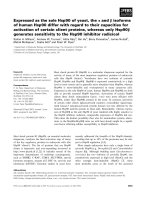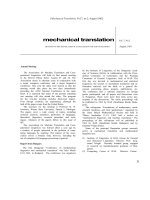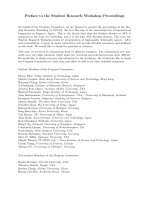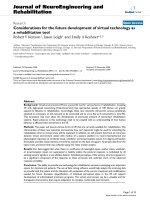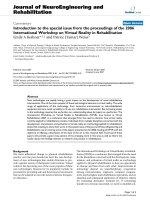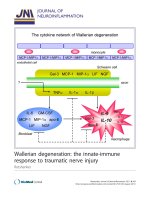Báo cáo hóa học: " Letter to the Editor A Further Result about “On the Channel Capacity of Multiantenna Systems with Nakagami Fading”" potx
Bạn đang xem bản rút gọn của tài liệu. Xem và tải ngay bản đầy đủ của tài liệu tại đây (440.97 KB, 2 trang )
Hindawi Publishing Corporation
EURASIP Journal on Advances in Signal Processing
Volume 2007, Article ID 84713, 2 pages
doi:10.1155/2007/84713
Letter to the Editor
A Further Result about “On the Channel Capacity of
Multiantenna Systems with Nakagami Fading”
Saralees Nadarajah
1
and Samuel Kotz
2
1
School of Mathematics, University of Manchester, Manchester M60 1QD, UK
2
Department of Engineering Management and Systems Engineering, The George Washington University,
Washington, DC 20052, USA
Received 3 June 2006; Revised 18 December 2006; Accepted 23 December 2006
Recommended by Dimitrios Tzovaras
Explicit expressions are derived for the channel capacity of multiantenna systems with the Nakagami fading channel.
Copyright © 2007 S. Nadarajah and S. Kotz. This is an open access article distributed under the Creative Commons Attribution
License, which permits unrestricted use, distribution, and reproduction in any medium, provided the original work is properly
cited.
1. INTRODUCTION
The recent paper by Zheng and Kaiser [1]derivedvarious
expressions for the channel capacity of multiantenna sys-
tems with the Nakagami fading channel. Most of these are
expressed in terms of the integral
J(k, β)
=
∞
0
log
1+
u
β
u
k/2−1
exp(−u)du,(1)
see, for example, [1, equation (14)]. The paper provided a re-
currence relation (see [ 1, equation (18)]) for calculating (1).
Here, we show that one can derive explicit expressions for (1)
in terms of well-known functions.
2. EXPLICIT EXPRESSIONS FOR (1)
We ca lculate (1) by direct application of certain formulas in
[2]. For k>0, application of [2, equation (2.6.23.4)] yields
J(k, β)
=
2πβ
k/2
k sin(kπ/2)
1
F
1
k
2
;1+
k
2
; β
−
Γ
k
2
log β − Ψ
k
2
−
2β
2 − k
2
F
2
1, 1;2, 2 −
k
2
; β
,
(2)
where Ψ(
·) denotes the digamma func tion defined by
Ψ(x)
=
d log Γ(x)
dx
,(3)
and
1
F
1
and
2
F
2
are the hypergeometric functions defined by
1
F
1
(a; b; x) =
∞
k=0
(a)
k
(b)
k
x
k
k!
,
2
F
2
(a, b; c, d; x) =
∞
k=0
(a)
k
(b)
k
(c)
k
(d)
k
x
k
k!
,
(4)
respectively, where ( f )
k
= f ( f +1)···( f +k−1) denotes the
ascending factorial. If k
= 2, then by [2, equation (2.6.23.5)]
one can reduce (2)to
J(2, β)
=−exp(β)Ei(−β), (5)
where Ei(
·) denotes the exponential integral defined by
Ei(x)
=
x
−∞
exp(t)
t
dt. (6)
If k
= 1, then by using the facts that
Ψ
1
2
=−
γ − 2log2,
1
F
1
1
2
;
3
2
; β
=
√
πerfi
β
2
β
,
(7)
where γ
= 0.5772 ··· is the Euler’s constant and erfi(·)de-
notes the imaginary error function defined by
erfi(x)
=
2
√
π
x
0
exp
t
2
dt,(8)
2 EURASIP Journal on Advances in Signal Processing
one can reduce (2)to
J(1, β)
= π
3/2
erfi
β
−
√
π
log β + γ +2log2− 2β
2
F
2
1, 1;2,
3
2
; β
.
(9)
If k
= 3, then by using the fac t s that
Ψ
3
2
=
2 − γ − 2log2,
1
F
1
3
2
;
5
2
; β
=
3exp(β)
2β
−
3
√
πerfi
β
4β
3/2
,
(10)
one can reduce (2)to
J(3, β)
=−πβ
1/2
exp(β)+
π
3/2
erfi
β
2
−
√
π
2
log β−2+γ +2log2+2β
2
F
2
1, 1;2,
1
2
; β
.
(11)
3. DISCUSSION
We expect that the expression given by (2) and its partic-
ular cases could be useful with respect to channel capac-
ity modeling of multiantenna systems with Nakagami fad-
ing. The given expressions involve the digamma, exponential
integral, imaginary error, and the hypergeometric functions
and these functions are well known and well established (see
[3, Sections 8.17, 8.21, 8.36, and 9.23]). Numerical routines
for computing these functions are widely available, see, for
example, Maple and Mathematica.
REFERENCES
[1] F. Zheng and T. Kaiser, “On the channel capacity of multi-
antenna systems with Nakagami fading,” EURASIP Journal on
Applied Signal Processing, vol. 2006, Article ID 39436, 11 pages,
2006.
[2] A. P. Prudnikov, Y. A. Brychkov, and O. I. Marichev, Integrals
and Series, vol. 1, Gordon and Breach Science, Amsterdam, The
Netherlands, 1986.
[3] I. S. Gradshteyn and I. M. Ryzhik, Table of Integrals, Series, and
Products, Academic Press, San Diego, Calif, USA, 6th edition,
2000.
Saralees Nadarajah is a Senior Lecturer in the School of Mathemat-
ics, University of Manchester, UK. His research interests include
climate modeling, extreme value theory, distribution theory, infor-
mation theory, sampling and experimental designs, and reliability.
He is an Author/Coauthor of four books and has over 300 papers
published or accepted. He has held positions in Florida, California,
and Nebraska.
Samuel Kotz is a distinguished Professor of statistics in the Depart-
ment of Engineering Management and Systems Engineering, the
George Washington University, Washington, DC, USA. He is the
Senior Co-editor-in-Chief of t he thirteen-volume Encyclopedia of
Statistical Sciences, an Author or Coauthor of over 300 papers on
statistical methodology and theory, 25 books in the field of statis-
tics and quality control, three Russian-English scientific dictionar-
ies, and Coauthor of the often-cited Compendium of Statistical Dis-
tributions.

